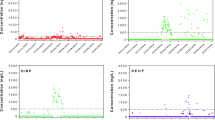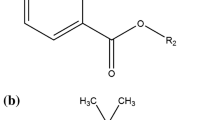Abstract
This paper reports, for the first time, the concentrations of selected phthalates in drinking water consumed in Portugal. The use of bottled water in Portugal has increased in recent years. The main material for bottles is polyethylene terephthalate (PET). Its plasticizer components can contaminate water by leaching, and several scientific studies have evidenced potential health risks of phthalates to humans of all ages. With water being one of the most essential elements to human health and because it is consumed by ingestion, the evaluation of drinking water quality, with respect to phthalate contents, is important. This study tested seven commercial brands of bottled water consumed in Portugal, six PET and one glass (the most consumed) bottled water. Furthermore, tap water from Lisbon and three small neighbor cities was analyzed. Phthalates (di-n-butyl phthalate ester (DnBP), bis(2-ethylhexyl) phthalate ester (DEHP), and di-i-butyl phthalate ester (DIBP)) in water samples were quantified (PET and glass) by means of direct immersion solid-phase microextraction and ionic liquid gas chromatography associated with flame ionization detection or mass spectrometry due to their high boiling points and water solubility. The method utilized in this study showed a linear range for target phthalates between 0.02 and 6.5 μg L−1, good precision and low limits of detection that were between 0.01 and 0.06 μg L−1, and quantitation between 0.04 and 0.19 μg L−1. Only three phthalates were detected in Portuguese drinking waters: dibutyl (DnBP), diisobutyl (DIBP), and di(ethylhexyl) phthalate (DEHP). Concentrations ranged between 0.06 and 6.5 μg L−1 for DnBP, between 0.02 and 0.16 μg L−1 for DEHP, and between 0.1 and 1.89 μg L−1 for DIBP. The concentration of DEHP was found to be up to five times higher in PET than in glass bottled water. Surprisingly, all the three phthalates were detected in glass bottled water with the amount of DnBP being higher (6.5 μg L−1) than in PET bottled water. These concentrations do not represent direct risk to human health. Regarding potable tap water, only DIBP and DEHP were detected. Two of the cities showed concentration of all three phthalates in their water below the limits of detection of the method. All the samples showed phthalate concentrations below 6 μg L−1, the maximum admissible concentration in water established by the US Environmental Protection Agency. The concentrations measured in Portuguese bottled waters do not represent any risk for adult's health.





Similar content being viewed by others
Notes
NOAEL denotes the level of exposure of an organism, found by experiment or observation, at which there is no biologically or statistically significant.
LOAEL is the lowest concentration or amount of a substance, found by experiment or observation, which causes an adverse alteration of morphology, functional capacity, growth, development, or life span.
References
Ai J (1997a) Solid phase microextraction for quantitative analysis in nonequilibrium situations. Anal Chem 69:1230–1236
Ai J (1997b) Headspace solid phase microextraction. Dynamics and quantitative analysis before reaching a partition equilibrium. Anal Chem 69:3260–3266
APIAM (2011) http://www.apiam.pt/conteudo/Um-mercado-sustentado/-/10. Accessed 19 Nov 2012
Asadollahzadeh H, Noroozian E, Maghsoudi S (2010) Solid-phase microextraction of phthalate esters from aqueous media by electrochemically deposited carbon nanotube/polypyrrole composite on a stainless steel fiber. Anal Chim Acta 669:32–38
Borodinsky L (2007) Technical Advisor's Report to the Food, Drug, and Cosmetic Packaging Materials Committee. http://www.plasticsindustry.org/files/about/fdcpmc/techpdfs/FDCPMCTechAdvisorReportJune07.pdf. Accessed 10 June 2013
Cao X-L (2008) Determination of phthalates and adipate in bottled water y headspace solid-phase microextration and gas chromatography/mass spectrometry. J Chromatogr A 1178:231–238
Cortazar E, Zuloaga O, Sanz J, Raposo JC, Etxebarria N, Fernández LA (2002) Multiplex optimisation of the solid-phase microextration-gas chromatographic-mass spectrometric determination of polycyclic aromatic hydrocarbons, polychlorinated biphenyls and phthalates from water samples. J Chromatogr A 978:165–175
Deblonde T, Cossu-Leguille C, Hartemann P (2011) Emerging pollutants in wastewater: a review of the literature. Int J Hyg Environ Health 214:442–448
Directive 2005/84/EC. http://eur-lex.europa.eu/LexUriServ/LexUriServ.do?uri=OJ:L:2005:344:0040:0043:en:PDF. Accessed 19 Nov 2012
Directive 82/711/EEC. http://eur-lex.europa.eu/LexUriServ/LexUriServ.do?uri=CONSLEG:1982L0711:19970901:EN:PDF. Accessed 19 Nov 2012
EFBW—European Federation of Bottled Waters (2010) Bottled water facts. http://www.efbw.eu/images/file/Bottled%20Water_Facts%20.pdf. Accessed 19 Apr 2013)
EPA Risk information for DEHP (2012) http://www.epa.gov/iris/subst/0014.htm. Accessed 20 Nov 2012
IBWA—International Bottled Water Association (2013) http://www.bottledwater.org/buyersguide/plastipak-packaging. Accessed 19 Apr 2013
Kamrin MA (2009) Phthalate risks, phthalate regulation, and public health: a review. J Toxicol Environ Health B 12:157–174
Kluwe WM, McConnell EE, Huff JE, Haseman JK, Douglast JF, HartwelIt WV (1982) Carcinogenicity testing of phthalate esters and related compounds by the National Toxicology Program and the National Cancer Institute. Environ Health Perspect 45:129–133
Miller JC, Miller JN (1988) Statistics for analytical chemistry. Ellis Horwood, Chichester
Montuori P, Jover E, Morgantini M, Bayona JM, Triassi M (2008) Assessing human exposure to phthalic acid and phthalate esters from mineral water stored in polyethylene terephthalate and glass bottles. Food Addit Contam 25:511–518
Penãlver A, Pocurull E, Borrull F, Marce RM (2000) Determination of phthalate esters in water samples by solid-phase microextraction and gas chromatography with mass spectrometry detection. J Chromatogr A 872:191–201
Penãlver A, Pocurull E, Borrull F, Marcé RM (2001) Comparison of different fibers for the solid-phase microextration of phthalate esters from water. J Chromatogr A 922:377–384
Polo M, Llompart M, Garcia-Jares C, Cela R (2005) Multivariate optimization of a solid-phase microextraction method for the analysis of phthalate esters in environmental waters. J Chromatogr A 1072:63–72
Preuss R, Koch HM, Angerer J (2005) Biological monitoring of the five major metabolites of di-(2-ethylhexyl)phthalate (DEHP) in human urine using column-switching liquid chromatography–tandem mass spectrometry. J Chromatogr B 816:269–280
Prokůpková G, Holadová K, Poustka J, Hajšlová J (2002) Development of a solid-phase microextraction method for the determination of phthalic acid esters in water. Anal Chim Acta 457:211–223
Ragonesea C, Sciarrone D, Tranchida PQ, Dugo P, Mondello L (2012) Use of ionic liquids as stationary phases in hyphenated gas chromatography techniques. J Chromatogr A 1255:130–144
Rodwan Jr JG (2011) Bottled water 2011: the recovery continues, U.S. and International Developments and Statistics. International Bottled Water Association, IBWA. http://www.bottledwater.org/files/2011BWstats.pdf. Accessed 18 Apr 2013
Sax L (2009) Polyethylene terephthalate may yield endocrine disruptors. Environ Health Perspect 118:445–448
Schmid P, Kohler M, Meierhofer R, Luzi S, Wegelin M (2008) Does the reuse of PET bottles during solar water disinfection pose a health risk due to the migration of plasticisers and other chemicals into the water? Water Res 42:5054–5060
Schuga TT, Janesickb A, Blumbergb B, Heinde JJ (2011) Endocrine disrupting chemicals and disease susceptibility. J Steroid Biochem Mol Biol 127:204–215
Shen H, Liu L, Bao H, Liu F, Zhang J (2012) Phthalates exposure of Chinese reproductive age couples and its effect on male semen quality, a primary study. Environ Int 42:78–83
Staples CA, Peterson DR, Parkerton TF, Adams WJ (1997) The environmental fate of phthalate esters: a literature review. Chemosphere 35:667–749
Staples CA, Stanley MK, Robillard KA (2003) Part Q. Phthalate esters. In: Staples CA (ed) The handbook of environmental chemistry, vol 3. Springer, Berlin
Tooley W, Feghhi S, Han S, Wang J, Sniadecki N (2011) Thermal fracture of oxidized polydimethylsiloxane during soft lithography of nanopost arrays. J Micromech Microeng 21:960–1317
Watercooler (2004) http://en.wikipedia.org/wiki/File:Watercooler_Wikinews.jpg. Accessed 19 Apr 2013
Wille K, De Brabander HF, De Wulf E, Van Caeter P, Janssen CR, Vanhaecke L (2012) Coupled chromatographic and mass-spectrometric techniques for the analysis of emerging pollutants in the aquatic environment. Trends Anal Chem 35:87–108
Wood A, Roberts S (2011) Economic geography: places, networks and flows. Routledge, New York. http://books.google.pt/books?id=w_b0i1sBFw0C&pg=PT165&lpg=PT165&dq=worldwide+consumption+of+bottled+water&source=bl&ots=E1hzx3PIbZ&sig=U1l8FlPwxp84b2D1yQf7JaelTzU&hl=pt-PT&sa=X&ei=JiNrULi4HsiXhQfN0YGgCw&ved=0CEgQ6AEwBA. Accessed 10 Nov 2012
Acknowledgments
The authors gratefully thank Sigma-Aldrich/Supelco (Silep program). The authors also acknowledge Dr. Pedro Gutiérrez Rivas for his support. Inês Nunes and José Santana acknowledge Portuguese Science and Technology Foundation (FCT) for their PhD grants. Clara Giraudi acknowledges her grant from Erasmus interchanging program.
Author information
Authors and Affiliations
Corresponding author
Additional information
Responsible editor: Markus Hecker
Part of this work was done under Erasmus students interchange program involving Faculdade de Ciências e Tecnologia, Universidade Nova de Lisboa, Portugal and University of Piemonte Orientale “Amadeo Avogadro, Italy.”
Rights and permissions
About this article
Cite this article
Santana, J., Giraudi, C., Marengo, E. et al. Preliminary toxicological assessment of phthalate esters from drinking water consumed in Portugal. Environ Sci Pollut Res 21, 1380–1390 (2014). https://doi.org/10.1007/s11356-013-2020-3
Received:
Accepted:
Published:
Issue Date:
DOI: https://doi.org/10.1007/s11356-013-2020-3




